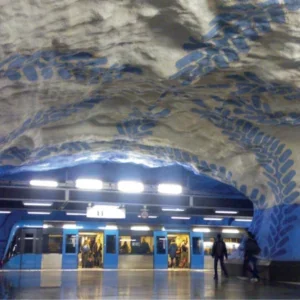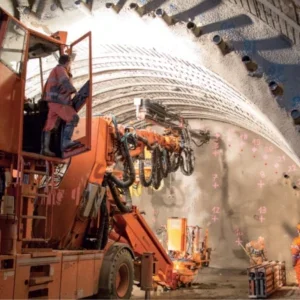The incentive to link Europe’s major cities with a high-speed rail link, capable of running trains at speeds of 300km/h, resulted in 1996 in the UK Parliament’s authorisation of the Channel Tunnel Rail Link (CTRL) Act. The act effectively gave the green light to construction of the $6.7bn CTRL, which will be the first major new railway in the UK for over a century and, upon completion, will halve the journey time between St Pancras Station in London and the Channel Tunnel in Folkestone, Kent.
The scheme has been divided into two construction phases: the 74km long Section 1 will link the Channel Tunnel with existing rail track at Fawkham Junction in North Kent, while the 39km long Section 2 (over half of which passes through tunnels) will connect Section 1 to St Pancras Station. An integral part of Section 1 is the 3.2km long North Downs Tunnel, which will run at depths of up to 100m under Bluebell Hill near Rochester in Kent in south east England.
With a height of 12.5m, a width of 14m and a cross-sectional area of approximately 160m², the twin-track tunnel will be one of the largest in terms of area in the UK. The $128m Contract 410 on Section 1 for construction of the North Downs Tunnel was awarded in October 1998 to the Eurolink consortium, a JV of Miller Civil Engineering/Dumez-GTM/Beton-und Monierbau.
Responsible for the construction, operation and finance of the complete CTRL scheme is London & Continental Railways (LCR), together with subsidiaries Union Railways (South) Ltd (URS), responsible for Section 1, and Union Railways (North) Ltd responsible for Section 2. Rail Link Engineering (RLE) is a consortium comprising the engineering shareholders in LCR: Bechtel; Ove Arup & Partners; Halcrow Group; and Systra, and is responsible for the design and project management of the rail link. The Eurolink/RLE design and construction team has adopted a modified New Engineering Contract using Option C, whereby the contract requires the contractor to self certify construction works within an incentivised target price contract. The contract was tendered and let under the partnering philosophy for the now obligatory ‘open book’ approach to design and construction.
Tunnel design
In the reference design, a twin-track configuration was envisaged with a minimum gross free area of 96.2m² to allow for the atmospheric conditions created in the tunnel when two trains are travelling at 300km/h towards each other. During the preliminary design stage, other methods of construction considered included twin TBM and NATM tunnels or a large-scale, semi-mechanised shield driven tunnel.
In the event, the tunnel dimensions and the predicted ground conditions dictated the technique and a single-tube, large-span NATM tunnel was decided on. Being a single-bore tunnel, safety features are imperative and the design includes provision of high-level evacuation walkways on either side of the tunnel.
Between January 1994 and October 1998, pre-construction ground investigations, including 30 rotary and cable toll driven exploratory boreholes and 17 trial pits were excavated to determine the geology and ground conditions of the area. The resulting geological profile shows, from the London portal, that the tunnel passes first through the town of Lewes in the Upper Chalk, a soft to medium hard alternating with a low to medium density chalk, having a total thickness of 50m.
The tunnel will then pass through into the New Pit Member (Middle Chalk), a thickly bedded alternating extremely soft to medium hard, low to medium density chalk, with a thickness of 44m with blocky characteristics. Next, the tunnel enters the Hollywell Member (Middle Chalk), a medium to very hard, medium to high density nodular chalk with a total thickness of 17m. The fourth and final formation is the Plenus Marl & White Bed (Lower Chalk). The Plenus Marl is a soft to medium hard, medium density marly chalk, with a thickness of 3-4m. The White Bed is a soft, medium density chalk with a thickness of 14m near Blue Bell Hill.
|
“Being a single-bore tunnel, safety features are imperative and the design includes provision of high-level evacuation walkways” |
A strict environmental standard was imposed on the design and construction of the tunnel during the passing of the CTRL act through Parliament. The environmental constraint Not Environmentally Worse Than (NEWT) was imposed whereby construction of the tunnel must not be environmentally worse than the reference design defined in the act.
In an attempt to identify potential for cost saving in tendered work while maximising efficiency, value engineering was incorporated at the design stage. The main areas that could be implemented without reducing the quality of the final works were highlighted. First, waterproofing of the tunnel was specified to Grade A watertightness. It was calculated that installing a waterproof membrane over the vault of the tunnel along its entire length would be more cost effective than the original design. This specified combining waterproof membrane emplacement in areas susceptible to groundwater ingress with crack control measures and the presence of water bars in all circumferential and radial movement joints.
Second, an extensive study was conducted to provide a design by which the permanent primary lining and the secondary lining would work together to negate the long-term loads on the complete tunnel lining. The design of the primary lining was by Beton-und Monierbau in Austria, checked by Miller and reviewed by the RLE design team. Specification for the primary lining is in accordance with British Standard BS 8110 for temporary works left in place
Tunnel construction and lining
Tunnelling started on April 16 1999 and is presently carried out 7 days/week, 24h/day, with six miners working on each shift. Construction of the tunnel is being undertaken from two portals, the London and Country portals, using the conventional method of top heading, bench and invert excavation. Identical equipment is used at both sites. Excavation is performed at each portal by a Paurat E242 roadheader; a Liebherr 932T excavator is used for trimming the weaker rock. Due to the large face area, spoil is removed at the same time as excavation using Liebherr 564 loading shovels and taken out of the tunnel by a conveyor system.
Initial support is provided by shotcrete primary lining reinforced by mesh, lattice girders and rockbolts. The top heading structure is formed and supported by Type 95/20/30 lattice girders set at 2m intervals except at the mapped zones of weaker rock, where spacing is reduced to 1m. Two layers of steel mesh are included in the top heading but reduced to one layer in the bench and invert.
Reinforcement is supplied by 15 x 4m long, 25mm diameter cement grouted rockbolts installed in the top heading arch with a maximum spacing of arch support bolting every 2m down the tunnel length. The rockbolts are placed using an Atlas Copco L2 rig with a man access basket.
The thickness of the shotcrete primary lining varies from 250mm in the top heading, 200mm in the bench and 150mm in the invert. The top heading is supported by 500mm thick tapered ‘elephant’s feet’. The wet sprayed concrete is applied using a Normet 9150 spraying system. The primary lining to date has met the required 25N/mm² 28 day characteristic strength between three to seven days.
Secondary lining will be in the form of a cast in-situ lining consisting of concrete to provide long-term support for the tunnel’s 120 year design life and is scheduled to start in September 2000. All the concrete is batched on site. A total of 40 000m³ of sprayed concrete is calculated to be needed for the primary lining and 140 000m³ of concrete for the secondary lining.
|
“Daily meetings are held between the partnering teams where aspects of NATM construction based on the monitoring data and shift excavation experience are discussed ” |
Monitoring
A strict monitoring regime is in place that allows a real time analysis of ground conditions during construction. The system also permits monitoring of any deformations and the build-up of stresses in the lining. A combination of a tunnel lining deformation study, surface settlement and geological logging is used to determine the performance of the primary lining. Tunnel deformation was monitored employing an electric theodolite with a coaxial measuring system and placing Bireflex targets at 25-50m intervals along the tunnel to draw up a 3D survey.
Using a computer program known as Dedalos it was possible to create live plots of tunnel deformation at each monitoring station. The results of this survey enabled RLE and Eurolink to develop a monitoring threshold plan that was broken down into three sub-sections: trigger; action; and evacuation. A suitable tunnel emergency plan could then be implemented depending on the extent of possible deformation. Monitoring of the elephant’s feet is also carried out to establish a threefold monitoring threshold similar to the one used for the rest of the tunnel.
Precise levelling across the centreline of the tunnel is the technique used to monitor surface settlement. Information on settlements at depth is provided by borehole extensometers along the tunnel alignment. Daily meetings are held at 16.00h between the partnering teams of Eurolink and RLE, where aspects of the NATM construction based on the monitoring data and shift excavation experience are discussed.
Progress to date.
Before the rock break from the tunnel wall in which a miner was seriously injured on November 26 construction of the Country portal was progressing 50% faster than the rates forecast in the contract programme. The accident came at a time when the project’s safety record showed an accident rate of less than half the national average.
Advances of up to 14m/day have been recorded at the Country portal as a result of the good ground conditions. At the time of T&T International’s visit, the crown had been excavated from the Country portal to a length of nearly 1.3km. The bench and invert had both reached 100m, and possible plans for bringing forward the scheduled excavation of the bench and invert were under consideration.
Works on the London portal continue as per schedule after delays caused by poor ground conditions during the initial portal excavation works and remedial works at the invert. Although the construction team anticipated difficulties, it found the area to contain more solution features than expected.
Excavation of the crown has now progressed to 300m, with the bench at 226m and the invert at 160m. Work on the project is scheduled for completion in April 2002.
Related Files
Landscape section
Performance chart
Location map






